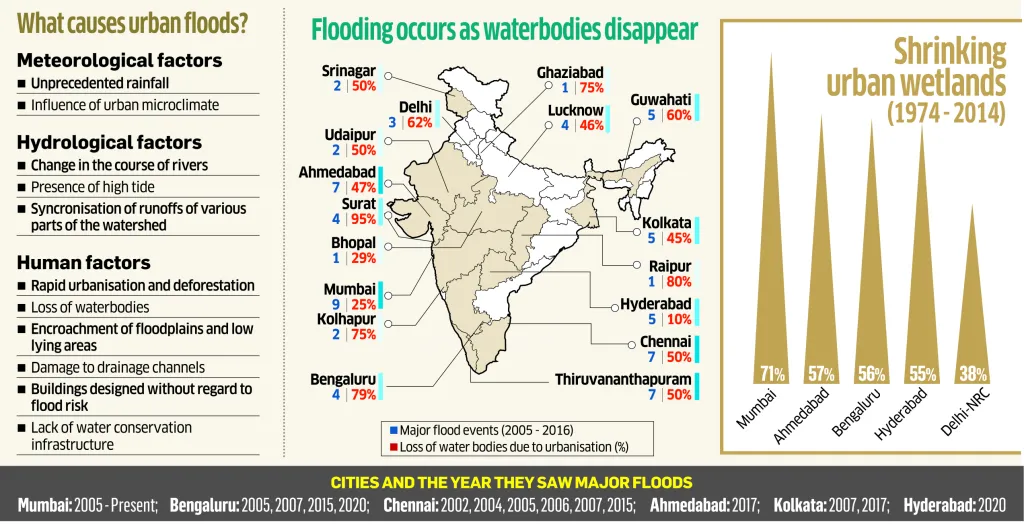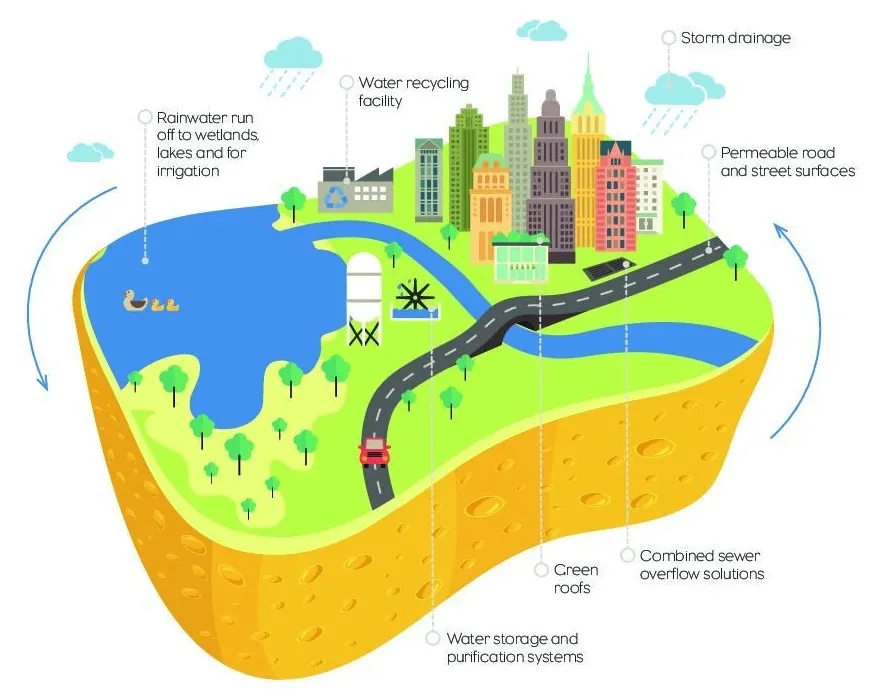Perils of Unplanned Urbanisation | 31 Jul 2023
This editorial is based on Smart ideas for big cities which was published in The Indian Express on 31/07/2023. It talks about unplanned urbanisation issues in India.
For Prelims: Central Water Commission, Monsoon, Catchment area, Flooding hotspot, Doppler radar, Drainage master plan, Rainwater harvesting, Wastewater treatment plan, Geographic information systems (GIS)
For Mains: Solution for Unplanned Cities in India, Mitigation measures for Flood Disaster
Urban flooding has become more frequent and severe in major cities across India in recent times. Cities like Delhi, Ahmedabad, Mumbai, Hyderabad, Srinagar, Chennai, and Bengaluru have experienced flooding during heavy rainfall. As a result, urban residents are facing problems like waterlogging and traffic jams, causing damage and disruption to their daily lives.
- The repeated and growing problems of urban floods is a systemic problem and the root cause of this is prioritising economic gains over everything else.
What is Urban Flooding?
- Urban Flooding is an inundation of land in a constructed setting, particularly in densely populated areas, caused by rainfall overwhelming the capacity of drainage systems.
- Urban flooding is significantly different from rural flooding as urbanization leads to developed catchments, which increases the flood peaks from 1.8 to 8 times and flood volumes by up to 6 times.
- Consequently, flooding occurs very quickly due to faster flow times (in a matter of minutes)
- Urban flooding is significantly different from rural flooding as urbanization leads to developed catchments, which increases the flood peaks from 1.8 to 8 times and flood volumes by up to 6 times.
What are the Causes of the Rise in Urban Flooding?
- Climate Change:
- Increases unpredictable weather patterns, leading to intense rainfall, heatwaves, and cyclones.
- Unplanned Urban Growth:
- Rapid expansion of unplanned illegal activities over natural resources makes cities vulnerable.
- With unplanned urbanisation and a rise in population, there has been a rise in construction (especially in low-lying areas) and, consequently, a loss of water bodies.
- Rapid expansion of unplanned illegal activities over natural resources makes cities vulnerable.
- Human Encroachment:
- Building on active flood channels leads to urban flooding.
- With cities getting more concretised (via pavements, roads, and settlements), rainwater percolation has reduced, leading to a rise in stormwater run-off.
- Building on active flood channels leads to urban flooding.
- Inadequate Flood Management:
- Many cities lack proper flood control practices. For example, urban India frequently experiences waterlogging, highlighting municipal unpreparedness.
- Most Indian cities are situated beside a river, with extensive floodplains and wetlands.
- India has lost 40 per cent of its wetlands in the past 30 years.
- For instance, Baroda lost 30 per cent of its wetlands between 2005 and 2018.
- Delhi had 1,000 waterbodies in 1997, but now has just 700. With such a loss of natural “blue infrastructure”, flooding risks have increased.
- Delhi has seen four major flooding events between 2005 and 2023.
- Waste Disposal Issues:
- Improper disposal of solid waste within drainage systems worsens the problem of flooding.
What are the Challenges Urban Areas Face Due to the Rise in Urban Flooding?
- Infrastructure Damage:
- Heavy rainfall and flooding can damage buildings and roads, disrupting daily life. Example: frequent waterlogging in Indian cities.
- Disruption of transportation:
- Flooded roads and public transportation systems can lead to traffic congestion and disruptions, making it difficult for people to move around the city.
- Emergency Response:
- Unexpected disasters strain city resources and redirect budgets from growth to recovery.
- Pollution Issues:
- Large amounts of contaminated runoff can overwhelm urban drainage systems, causing flash floods.
- Public health risks:
- Urban flooding can lead to waterborne diseases, contaminated drinking water, and the spread of pathogens.
- Food, Water, and Energy Security:
- Natural disasters threaten these basic needs, especially in coastal cities.
- Social inequality:
- Urban flooding often disproportionately affects vulnerable populations, including low-income communities and marginalized groups.
What are the Gaps in India's Urban Planning?
- Neglect of water body mapping:
- The country lacks comprehensive mapping and documentation of surface water bodies, despite being mentioned in the National Database for Mapping Attributes. The absence of such information hampers effective flood management and urban planning.
- Inadequate early-warning system:
- The failure to implement a reliable early-warning system was evident during the devastating floods in Uttarakhand in 2013.
- The National Disaster Management Authority (NDMA) couldn't effectively inform people about the impending floods and landslides, leading to a lack of timely evacuation measures.
- Reactive rather than proactive approach:
- Urban planning authorities and government agencies only seem to recognize the importance of disaster preparedness after facing significant disasters like the Chennai Floods in 2015 and Kerala Floods in 2018.
- Limited local bodies' preparedness:
- Local governments often lack sufficient training, equipment, and facilities to handle disaster situations efficiently. The onus of disaster mitigation predominantly falls on NDMA/SDMA, highlighting the need for stronger local-level response capabilities.
- Misuse of disaster funds:
- Funds allocated to the National Disaster Response Force (NDRF) and State Disaster Response Force (SDRF) for disaster management are sometimes mis utilized for expenses unrelated to disaster management. This financial indiscipline raises concerns about the efficient utilization of resources.
What Should be Done?
- Conduct Studies and Develop Management Plans:
- Conduct studies in all cities to understand catchment areas and flooding risks associated with urban water bodies and land use.
- Develop short, medium, and long-term measures to rejuvenate water bodies;
- Define lake and river management plans and involve local citizens in upkeep and removal of encroachments.
- Utilize Geographic Information Systems (GIS) to tag local water bodies, track encroachments, and understand seasonality.
- Invest in Early Warning Systems and Data Integration:
- Invest in more early warning systems, including Doppler radar, for real-time updates on changing weather patterns.
- Integrate local rainfall data with the Central Water Commission and regional flood control efforts.
- Conduct simulations for flooding hotspots, especially as rainfall patterns change.
- Develop City-Wide Databases and Disaster Relief Mechanisms:
- Invest in city-wide databases to provide immediate relief in the event of a flooding-related disaster.
- Revamp and Expand Drainage and Stormwater Networks:
- Develop Drainage Master Plans for Cities:
- Survey existing pipelines (drain or stormwater) and identify water-logging locations.
- Improve Urban Planning and Coordination:
- Improve coordination between agencies and institutions involved in urban water management.
- Raise awareness about wetland and water body conservation.
- Develop a well-defined urban water policy.
- Empower regulatory bodies like the Central Wetland Regulatory Authority with statutory powers.
- Encourage civic participation in urban water management.
- Follow the recommendation by the Draft New National Water Policy :
- There is a need for renewed thrust on protection and revival of traditional local water bodies in both urban and rural areas.
- These water bodies would form part of urban blue-green infrastructure for improved water levels and quality, as also flood mitigation, through specifically curated infrastructure such as rain gardens and bioswales, urban parks, green roofs and green walls etc.
- There is a need for renewed thrust on protection and revival of traditional local water bodies in both urban and rural areas.
Examples of Successful Initiatives to Check Urban Flooding:
- Mangalore City Corporation (MCC) established wastewater treatment plants with end-user linkages to address limited and erratic water supply for industries.
- Kaikondrahalli Lake in Bengaluru underwent desilting, removal of vegetation, and increasing its depth and storage capacity by 54% to combat sewage inflow and eutrophication.
- Some countries are experimenting with concept of Sponge Cities.
- Sponge City is a type of city which is designed in such a way that it acts like a sponge for rainwater. The water is absorbed and allowed to naturally filter through the soil to reach the aquifers. The aquifer recharge helps fulfil the water needs of the city.
What Initiatives are Taken by Government of India for Urban Development?
Conclusion:
- The Ministry of Earth Sciences' Climate Change Assessment Report (2020) highlights a concerning trend of increased heavy rainfall frequencies, leading to heightened flood risk across India, especially in urban areas.
- Urgent action is imperative to address this issue effectively. Successfully tackling the challenge of urban floods demands a collaborative approach involving the Union, State, and Local Governments, as well as active participation from citizens.
|
Drishti Mains Question: Discuss the issues and various causes of urban floods in India. Give some measures to prevent urban flooding in India. (250 words) |
UPSC Civil Services Examination Previous Year’s Question (PYQs)
Mains:
Q. Account for the huge flooding of million cities in India including the smart ones like Hyderabad and Pune. Suggest lasting remedial measures. (UPSC 2020 GS-1)


